India-Pakistan Conflict 2025: Fighter Jets, Missiles, and Drones
May 11, 2025
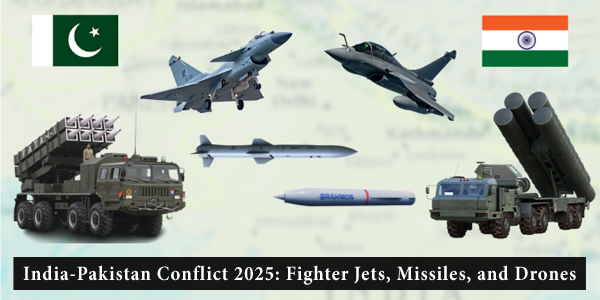
Rafales, Su-30MKIs, J-10C, JF-17 Thunders, Missiles, and Drones engaged in the 2025 India-Pakistan Conflict
The uneasy calm along the India-Pakistan border shattered in early May 2025, as the two nuclear-armed nations found themselves locked in yet another standoff. This time, however, the tools of war were quieter, faster, and far more precise. Fighter jets, missiles, and drones plunged South Asia’s most volatile frontier into its most intense aerial confrontation in years.
In what Indian officials have dubbed ‘Operation Sindoor’, the Indian Air Force (IAF) launched cross-border airstrikes into Pakistani territory, deploying long-range SCALP cruise missiles, HAMMER precision-guided bombs, and loitering munitions.
Pakistan’s response was swift. The Pakistan Air Force (PAF) scrambled JF-17 and J-10C fighters armed with PL-15 beyond-visual-range missiles, engaged Indian Rafales, downed five Indian fighter jets, and intercepted drones over multiple urban and border areas. What followed was a high-stakes demonstration of next-generation air warfare—featuring Rafale and J-10C fighters, PL-15 missiles, SCALP munitions, and a wide arsenal of drones, including kamikaze and loitering types.
India and Pakistan’s Aerial Clash
More than 110 fighter jets from India and Pakistan clashed in the skies for over an hour on May 7, in what analysts describe as the largest aerial engagement in modern history. The dogfight, involving approximately 72 Indian and 42 Pakistani aircraft, marks a new chapter in air combat, combining advanced warplanes, real-time targeting data, and long-range missiles in a tightly contested encounter.
The clash mainly involved Pakistan Air Force’s JF-17 Thunder and J-10Cs and Indian Air Force’s Rafales, Su-30MKIs, and MiG-29s. Both sides deployed airborne early warning systems (AWACS) to coordinate real-time targeting, and long-range air-to-air missiles such as the PL-15 and Meteor were reportedly used.
Timeline of Key Events
The clashes between India and Pakistan mark the most serious aerial escalation between the two since the 2019 conflict, pushing the subcontinent closer to a full-scale confrontation than at any time in recent years.
April 22, 2025: A militant attack in India-administered Kashmir killed over two dozen civilians. India blamed groups based in Pakistan, which utterly denied the allegations.
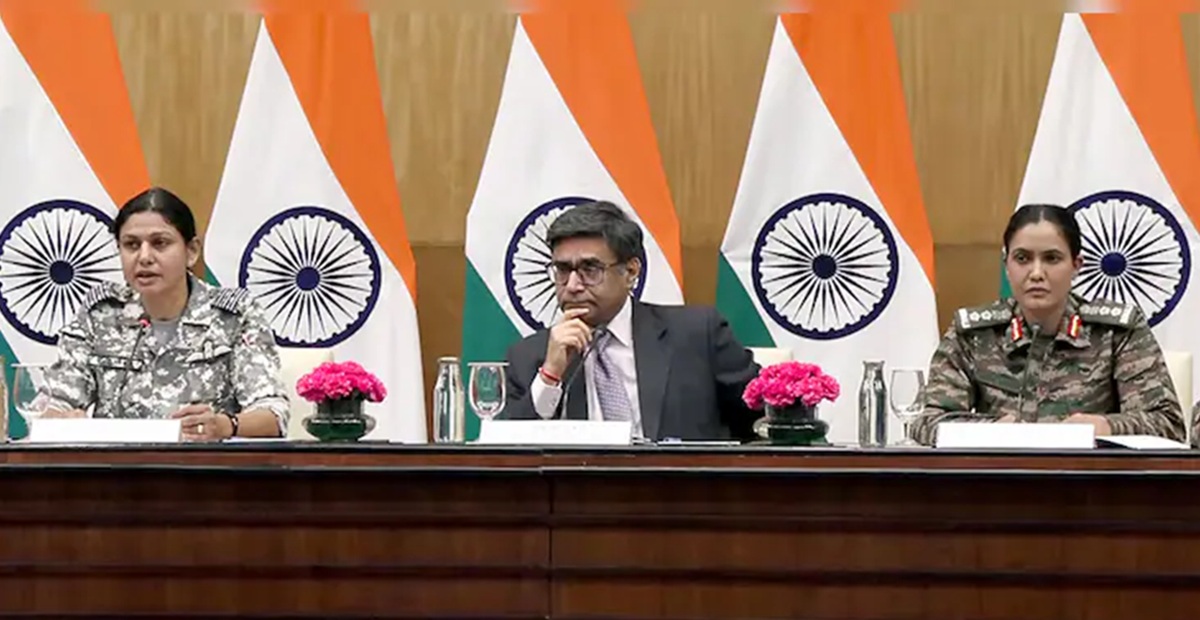 India's Foreign Secretary Vikram Misri, Colonel Sofiya Qureshi, and Wing Commander Vyomika Singh at the briefing on Operation Sindoor. (Image Credit: NDTV)
India's Foreign Secretary Vikram Misri, Colonel Sofiya Qureshi, and Wing Commander Vyomika Singh at the briefing on Operation Sindoor. (Image Credit: NDTV)
May 7, 2025: India launched an overnight military operation, hitting targets inside Pakistan, using Rafales, Russian-made jets, SCALP missiles, and HAMMER bombs. At least 31 Pakistani civilians were killed and dozens were injured.
May 7, 2025: Pakistan scrambled JF-17 Thunder and J-10C fighter jets and claimed to have shot down five Indian jets, including three French-made Rafales, a MiG-29, and a Su-30 fighter jet. Pakistan vowed revenge but also claimed “victory” for downing Indian aircraft.
May 8-9, 2025: India deployed kamikaze and surveillance drones. Pakistan downed 77 Indian drones. Three civilians were killed, and four soldiers were wounded in drone attacks. In response, Pakistan also launched drones against India.
May 10, 2025: In the early hours of May 10, India fired missiles on three air bases in Pakistan, including Nur Khan Air Base in Rawalpindi, PAF Rafiqui base near Shorkot, Jhang District, and Murid air base near Chakwal district of Punjab province. Pakistan claimed most missiles were intercepted, and no major damage occurred. Shortly after, Pakistan launched military operation “Bunyan Marsoos” (Iron Wall) and conducted missile strikes on 26 targets in India.
May 10, 2025: India and Pakistan agreed to a ceasefire that officially took effect around 5 P.M. local time on May 10. U.S. President Donald Trump confirmed the news.
French-made Rafales and China-made JF-17 and J-10Cs in skies
The skies over the border between Pakistan and India became a battleground as India’s Rafale fighter jets and Pakistan’s JF-17 and J-10C aircraft squared off in high-stakes aerial combat.
India’s Rafales, known for their versatility and precision, played a central role in the ongoing conflict, leveraging their advanced avionics and integration with long-range weapons like the SCALP missile. These multirole fighters are equipped with the SPECTRA electronic warfare system and the RBE2-AA Active Electronically Scanned Array (AESA) radar, capable of tracking multiple targets at long ranges.
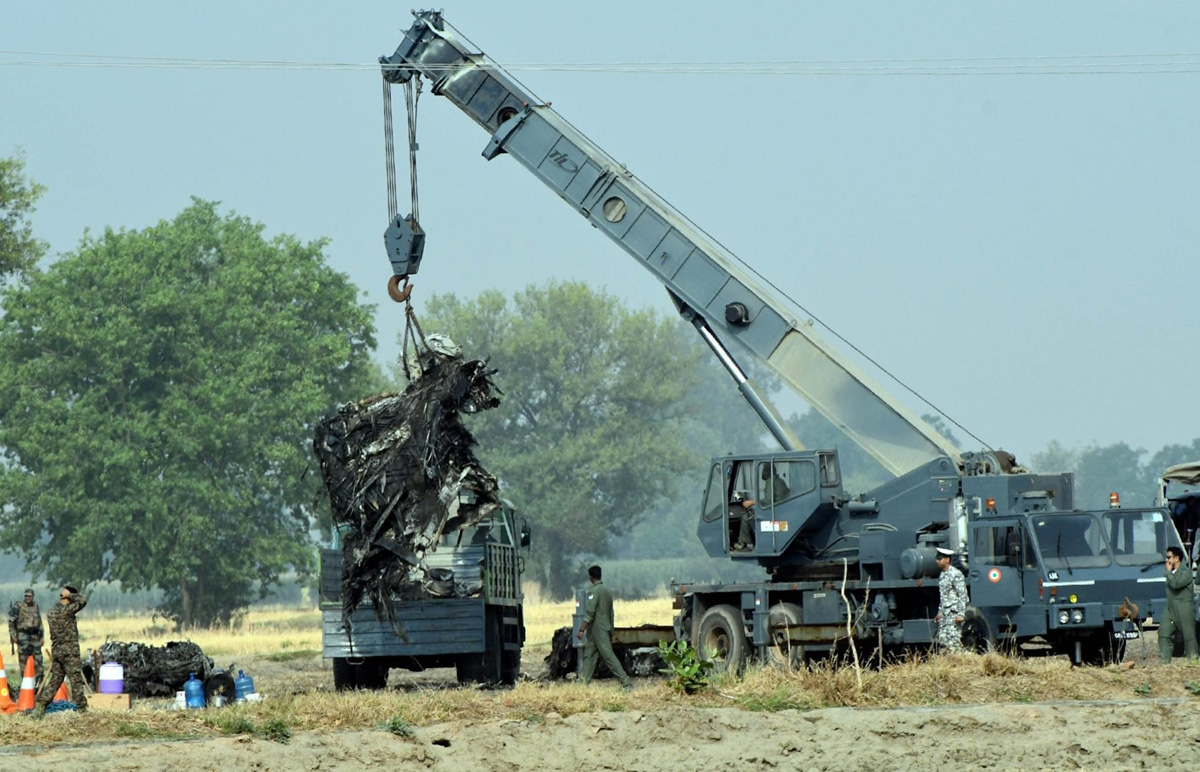 Indian Army recovers likely Rafale fighter jet wreckage in Aklia village near Goniana Mandi, Bathinda. (Image Credit: X/@clashreport)
Indian Army recovers likely Rafale fighter jet wreckage in Aklia village near Goniana Mandi, Bathinda. (Image Credit: X/@clashreport)
On the other hand, Pakistan's J-10C, a Chinese-made 4.5 generation fighter, is equipped with the indigenously developed KLJ-7A AESA radar and PL-15, one of the most advanced air-to-air missiles in the region, boasting a range of over 150 kilometers and capable of locking onto targets at high altitudes. This clash in the skies highlighted the asymmetry between the two nations’ aerial capabilities, particularly in terms of technological edge, with Chinese aerial systems proving as effective as their European counterpart.
The PAF also deployed its latest variant, the JF-17 Block III, equipped with advanced avionics and the Chinese-made PL-15 beyond-visual-range air-to-air missile (BVRAAMs). These aircraft played a crucial role in air defense and interception missions during the conflict.
The JF-17 Thunder, jointly developed by Pakistan and China, is a cost-effective yet capable multirole platform. Equipped with modern avionics, AESA radar, and compatibility with a wide range of air-to-air and air-to-ground munitions, the JF-17 enables Pakistan to maintain credible deterrence and operational flexibility.
SCALP and HAMMER Precision strikes
As the conflict moved beyond aerial engagements, the Indian Air Force launched precision strikes using SCALP cruise missiles and HAMMER guided bombs on May 7. These were the first operational use of the SCALP missiles by the IAF. SCALP, with its range of over 250 kilometers, allowed India to strike deep while keeping their fighter jets outside of Pakistani air defense zones.
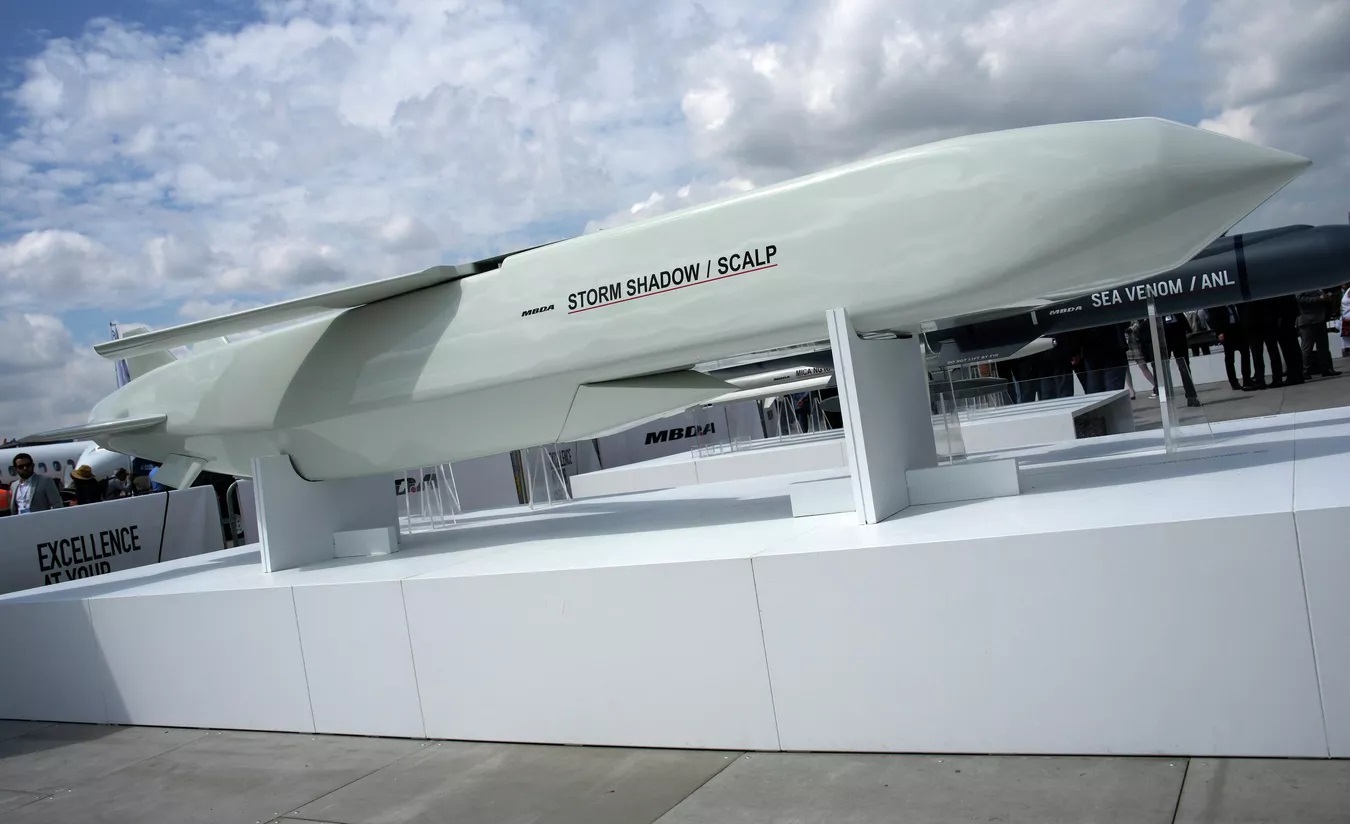 The SCALP Storm Shadow cruise missile is on display during the Paris Air Show in Le Bourget, France, on June 19, 2023. (Image Credit AP/Lewis Joly)
The SCALP Storm Shadow cruise missile is on display during the Paris Air Show in Le Bourget, France, on June 19, 2023. (Image Credit AP/Lewis Joly)
The HAMMER bombs, with their 70-kilometer range and modular payload, were deployed against high-value, fortified targets. These precision-guided munitions, alongside the SCALP, allowed India to focus on minimizing collateral damage while maximizing the precision and effectiveness of each strike. The use of these weapons reflected India's evolving military doctrine, which now places a premium on long-range, low-collateral damage warfare.
PL-15 Missile sees first combat use by PAF
Amid the dense fog of the ongoing India-Pakistan air conflict, one development that stands out is the likely first-ever combat use of China’s PL-15 BVRAAM by the PAF. The missile, which boasts a range of over 150 km, was launched by Pakistani fighters in engagements with Indian Rafales. Its advanced active radar homing system allows it to target enemy aircraft beyond visual range, providing Pakistan’s air force with a powerful instrument to counter the high-tech threat posed by India’s air superiority.
The battle for control of the skies led to the downing of Indian Rafale jets by the PAF in a significant blow to India’s air dominance. This marks the potential first combat loss of a Dassault jet. A French intelligence official confirmed at least one Rafale loss during the high-stakes engagement, with the ongoing investigation into whether more than one Rafale was brought down by Pakistan.
 Chinese AVIC PL-15 missile. (Image Credit: Chinese social media)
Chinese AVIC PL-15 missile. (Image Credit: Chinese social media)
French newspaper Le Monde reported that India’s cross-border strikes in Pakistan, intended as a demonstration of military strength, revealed significant weaknesses in the Indian Air Force. India has acknowledged the loss of at least three fighter jets, including a Rafale, according to French media. Analysts said that this development has raised questions about the effectiveness of India's air strategy and the vulnerability of its advanced aircraft in high-intensity conflicts.
Pakistan downs multiple Indian jets, Wreckage reveals evidence
In the aftermath of intense aerial combat, wreckage from downed fighter jets and missiles was recovered from India’s Punjab province and India-administered Kashmir and the border regions.
In the Hoshiarpur district Indian state of Punjab, images surfaced online showing what defense analysts say is likely the body of a Chinese-made PL-15 air-to-air missile—complete with serial numbers and a seeker test port—presumably fired by PAF J-10C or JF-17 Block III.
Elsewhere, in India’s Bathinda district, what appears to be the tailfin and rudder of a downed Rafale fighter was photographed bearing the serial number BS-001, identifying it as a single-seat Rafale EH. This supports earlier reports from local authorities and eyewitnesses of multiple Indian fighter jets crashing across Indian-administered Kashmir and Punjab.
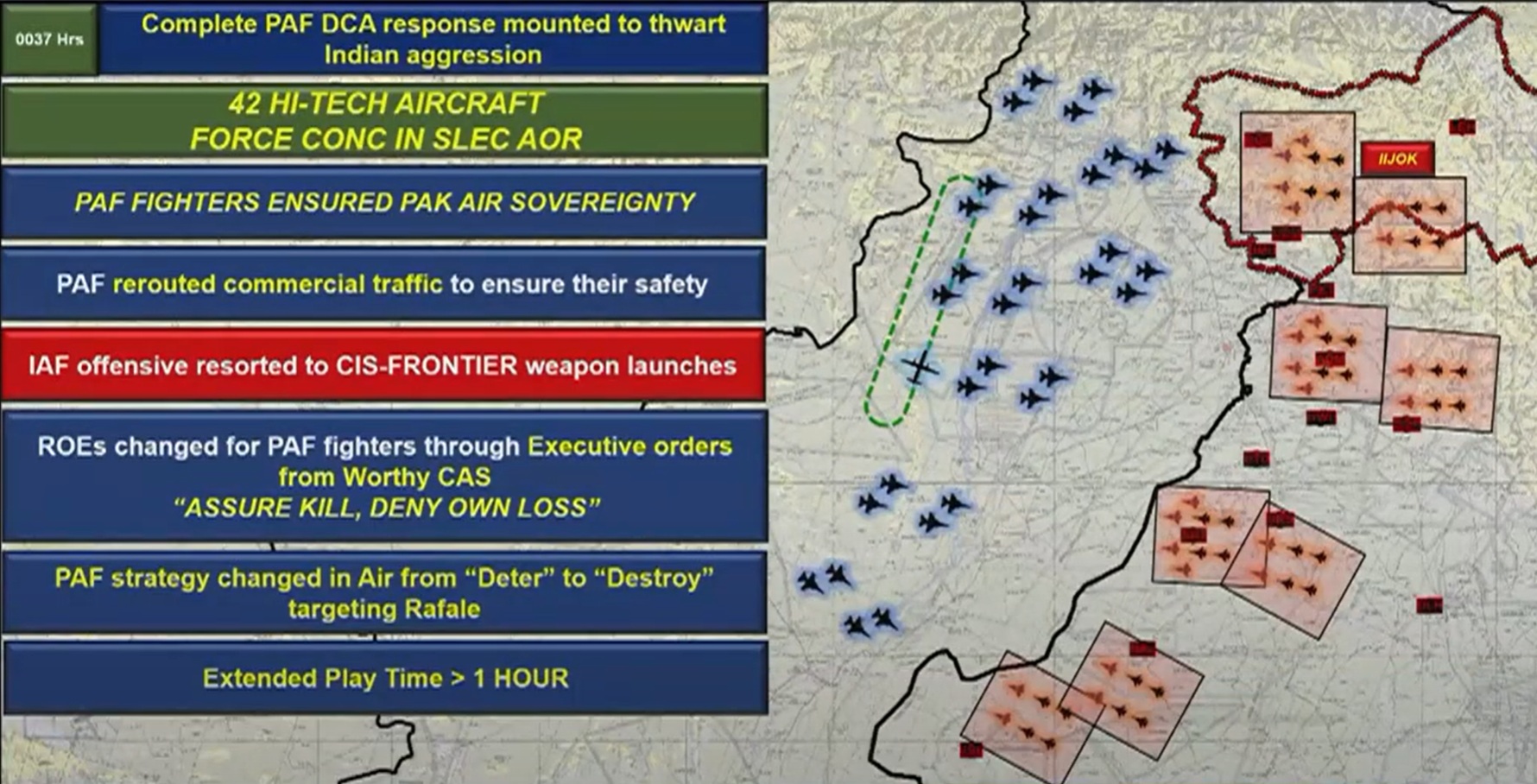 Pakistan Air Force briefing on recent India-Pakistan aerial conflict, on May 7, 2025. (Image Credit: PAF/PTV)
Pakistan Air Force briefing on recent India-Pakistan aerial conflict, on May 7, 2025. (Image Credit: PAF/PTV)
Further debris continues to fill in the picture of the intense air exchange. In the village of Aklian Kalan, just miles from Bathinda Air Force Station, locals filmed the apparent remains of a French-made MBDA MICA missile, used by both the Rafale and Mirage 2000, as well as its launch rail. Meanwhile, unverified footage from several sites in India showed aircraft engines, one of which resembled those found on the Rafale.
Reuters reported that at least three Indian aircraft are believed to have been lost in the fighting, however, New Delhi has not officially confirmed any losses. The U.S. officials have also confirmed that Pakistani fighter jets, most likely J-10, shot down at least two Indian military jets, including Rafale. Earlier, India completely denied losing any fighter jets; however, during the May 10 briefing, Indian Air Marshal AK Bharti refrained from commenting on the question regarding how many jets did IAF lost and said that India is in a combat situation, so there will be losses.
While exact tallies remain unclear, battlefield wreckage now serves as a grim catalog of modern aerial warfare. Analysts noted that the Pakistan Air Force relied on its Chinese-made J-10C and JF-17 Block III jets for the engagements, with no confirmed use of U.S.-made F-16s in the shootdowns.
NYT: "One Indian official confirmed the crash of three aircraft, but cautioned that the reasons were not clear. Two other Indian security officials confirmed reports that some Indian aircraft had gone down, but would not elaborate on the details"
— Shashank Joshi (@shashj) May 7, 2025
Drones in action during the 2025 India-Pakistan conflict
While drones have become central to warfare in the Ukraine-Russia war, their role in the India-Pakistan conflict has remained more limited, focusing on reconnaissance and precision strikes. The 2025 India-Pakistan conflict can be described as the world’s first drone war between two nuclear-armed neighbors.
The deployment of advanced drones such as the Israeli-made Harop loitering munition and India’s indigenous kamikaze drones highlighted the country’s focus on integrating cutting-edge technology into its military operations.
During the May 2025 conflict, India deployed advanced drones like the Harop, produced by Israel Aerospace Industries (IAI), which combines the functions of both an unmanned aerial vehicle (UAV) and a missile for precise strikes. Alongside the Harop and Heron, India utilized the Nagastra-1, an indigenous kamikaze drone, effective in targeting small, high-value assets such as mobile artillery and command posts. These drones provided real-time intelligence, enhancing India's ability to conduct targeted operations and respond dynamically to battlefield developments without risking pilot lives.
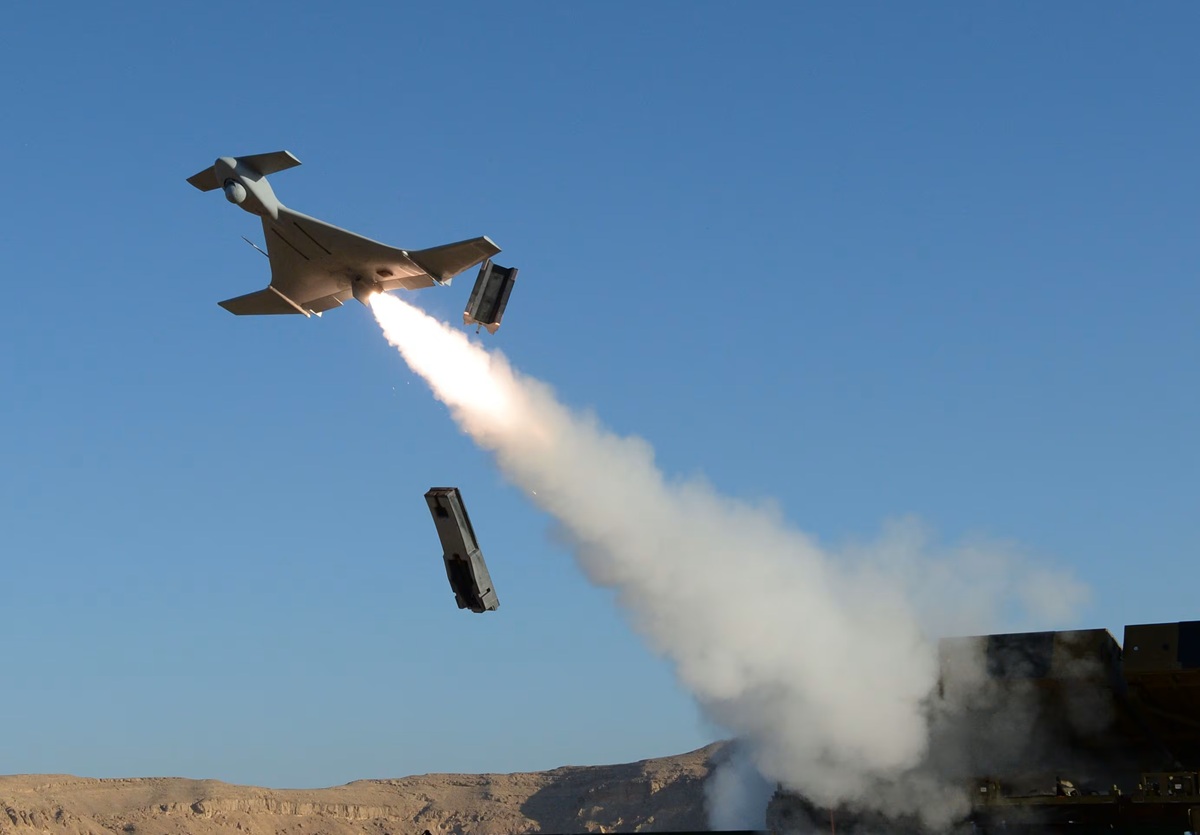 India used Israel Aerospace Industries' Harop kamikaze drones to attack Pakistan. (Image Credit: IAI)
India used Israel Aerospace Industries' Harop kamikaze drones to attack Pakistan. (Image Credit: IAI)Pakistan’s diverse drone fleet includes over a thousand UAVs from China, Turkiye, and local manufacturers. These include the CH-4, Bayraktar Akinci, and Pakistan’s own Burraq and Shahpar drones. While the exact drones used in the May 2025 conflict remain unclear, Indian reports suggest that Turkish-made Asisguard SONGAR armed drones were involved. This exchange of drone strikes marks a significant escalation in the India-Pakistan rivalry and marks a pivotal shift in warfare, enhancing precision strikes and real-time intelligence. As both nations continue to deploy unmanned systems, drones are poised to reshape military strategies and influence the region’s balance of power.
Pakistan shoots down 84 Indian drones
Pakistan’s military claimed significant success in its air defense efforts, announcing the downing of 84 Indian drones in or around multiple locations, including Lahore, Chakwal, Attock, and Gujranwala. Pakistan’s ability to shoot down a large number of these loitering munitions highlights the growing sophistication of its air defense systems, which reportedly include a mix of radars, electronic warfare units, and surface-to-air missiles designed to neutralize drone threats.
This success in countering Indian drone operations is a testament to the evolving nature of aerial defense and the challenges posed by small, agile loitering munitions that can bypass traditional defense systems. Yet, with India expanding its drone fleet, analysts say unmanned aerial systems will remain central to the evolving regional airpower equation.
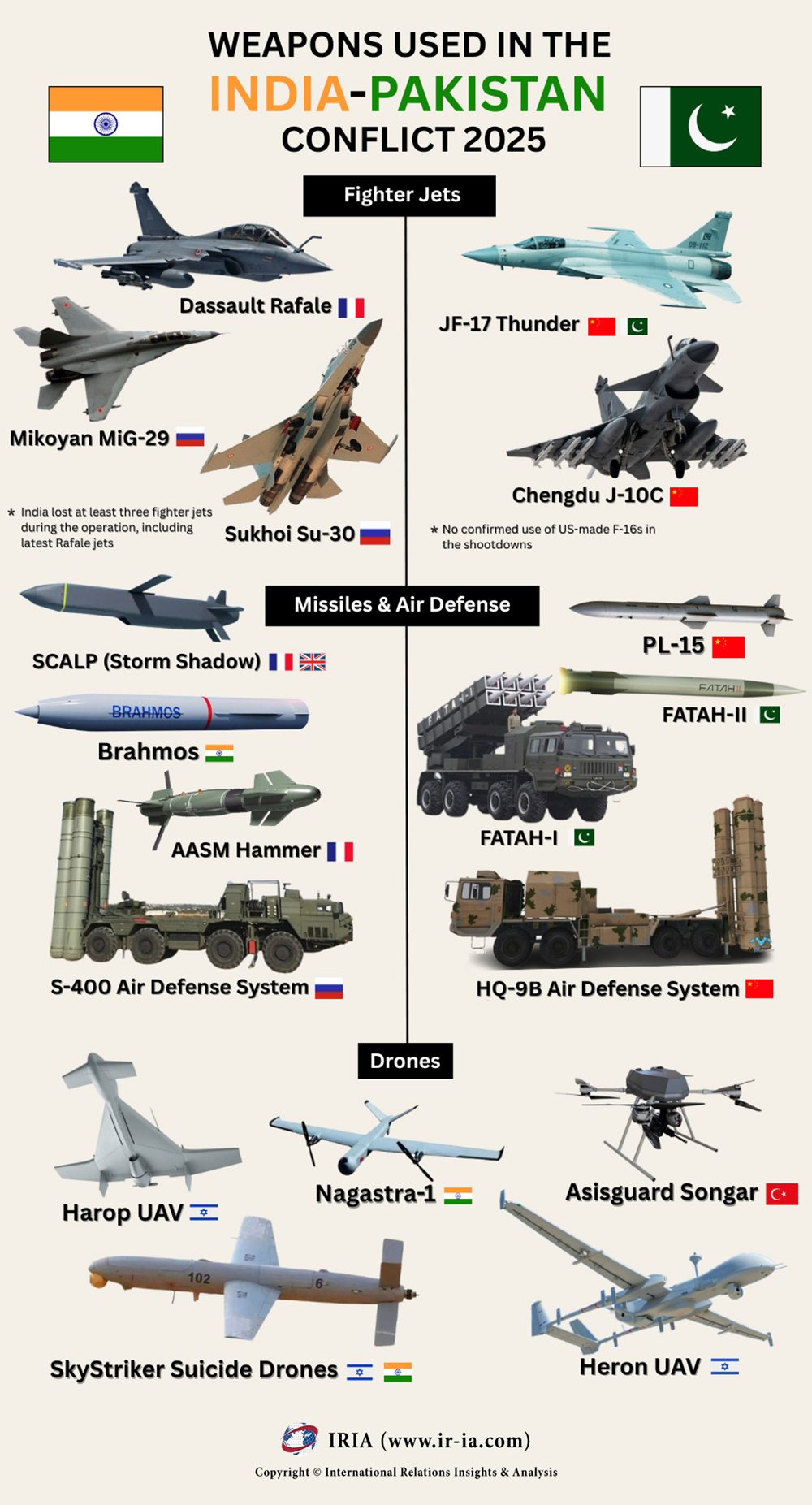
India’s deployment of loitering munitions in densely populated zones like Lahore and Chakwal has sparked serious concern. Experts warn that even precision-guided drones pose a risk to civilians when deployed so close to urban zones. The possibility of malfunction, miscalculation, or unintended detonation raises ethical questions about acceptable rules of engagement in modern warfare.
Pakistan hits back with Fatah Missiles in response to India’s strikes
Long-range fires have become a critical asset in modern warfare. On May 10 at 5 am local time, Pakistan responded to India's missile strikes on its airbases by launching retaliatory strikes using the Fatah-I and Fatah-II missile systems. The Fatah-I, a multiple launch rocket system (MLRS), has a range of over 140 kilometers, with each launcher carrying eight rockets. A more advanced version, the Fatah-II, extends this capability further, boasting a range of up to 400 kilometers, significantly enhancing Pakistan’s ability to deter and respond to regional threats.
These strikes came in response to India’s missile strikes targeting three Pakistani military bases in Rawalpindi, Shorkot, and Chakwal, according to Pakistan military spokesperson Lieutenant General Ahmed Sharif Chaudhry. In retaliation, Pakistan launched Operation “Bunyan Marsoos” (Iron Wall), targeting key Indian military sites, including Udhampur airbase, Pathankot airfield, brigade headquarters in Uri, and the BrahMos missile storage facility in Beas. Pakistan also claimed to have destroyed India's S-400 air defense system in Adampur with hypersonic missiles fired by the JF-17 jet.
India has acknowledged Pakistan’s attacks, confirming that Pakistan attempted to infiltrate or engage targets at more than 26 locations. Indian Wing Commander Vyomika Singh reported the use of heavy-caliber weapons and drones by Pakistan, including a high-speed missile targeting an airbase in Punjab. Colonel Sophia Qureshi confirmed damage at four Indian airbases — Udhampur, Pathankot, Bhuj, and Bathinda.
Pakistan launches Fatah missiles at Indian air bases and missile storage sites in a major retaliatory strike. pic.twitter.com/pnlo49huFs
— IRIA (@IRIA_Research) May 10, 2025
Air Power and Drones redefine the future of India-Pakistan Warfare
The 2025 India-Pakistan air conflict marks a turning point in regional military strategy, with both nations relying heavily on advanced air power and unmanned systems to achieve rapid, targeted results. Precision-guided munitions, long-range missiles, and loitering drones replaced conventional dogfights, signaling a shift toward more calculated and technology-driven warfare.
This underscores how drones and smart weapons are not only reshaping battlefield tactics but also redefining the very concept of deterrence and force projection. As India and Pakistan continue refining these tools, their experiences in this conflict will likely influence the future direction of air warfare in South Asia, where speed, precision, and automation are quickly becoming the new benchmarks of power.
Details of aircraft, platforms, and weapons used in the India-Pakistan conflict
Experts and analysts, along with open-source intelligence (OSINT) accounts, have speculated that these platforms and weapons may have been used by both sides during the conflict, though these details remain unconfirmed by official sources.
Indian Weapons, Aircraft, and Drones
Aircraft:
• Dassault Rafale: Used for precision airstrikes with SCALP cruise missiles, Hammer bombs, and loitering munitions.
• Sukhoi Su-30MKI: Multirole fighter, likely used for air superiority missions.
• MiG-29: Combat aircraft, engaged in air-to-air combat.
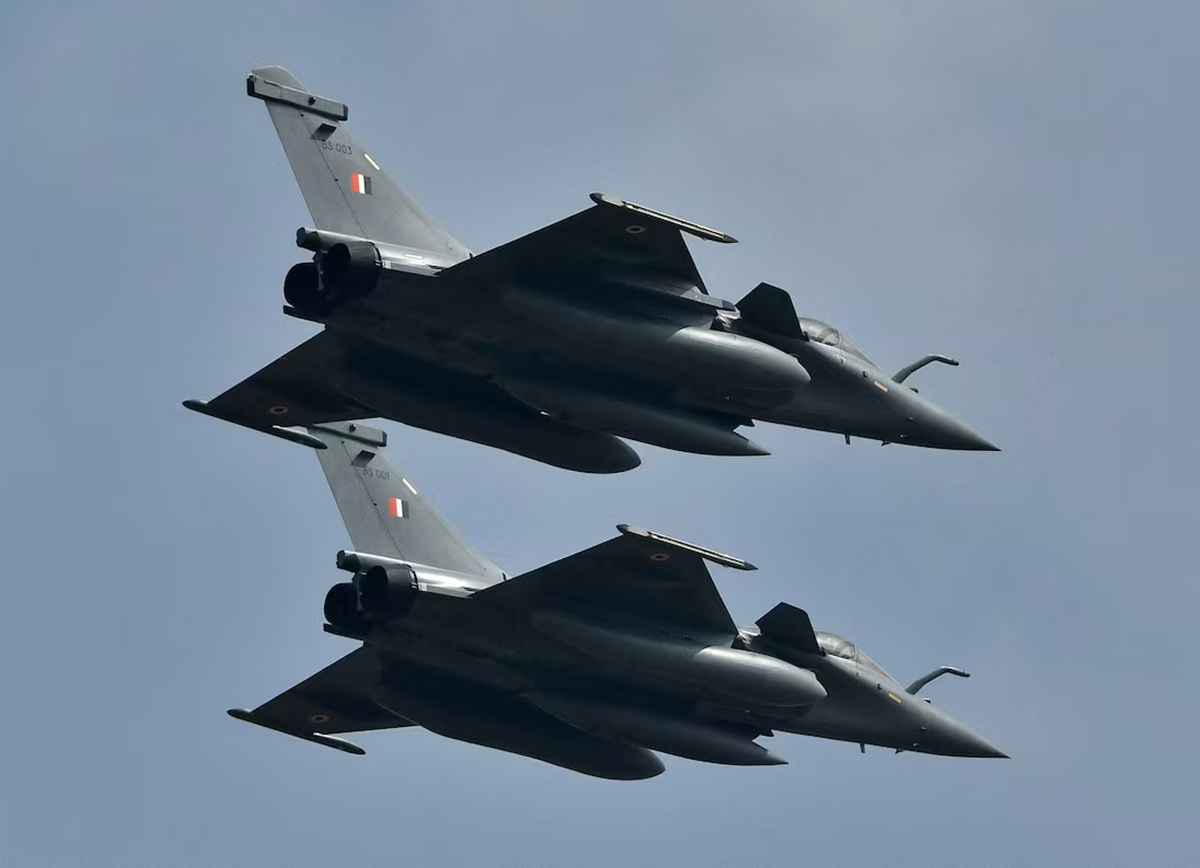 Indian Air Force's Rafale fighter jets fly past during the "Aero India 2021" air show at Yelahanka air base in Bengaluru, India, on February 3, 2021. (Image Credit: Reuters/Samuel Rajkumar/via X)
Indian Air Force's Rafale fighter jets fly past during the "Aero India 2021" air show at Yelahanka air base in Bengaluru, India, on February 3, 2021. (Image Credit: Reuters/Samuel Rajkumar/via X)Drones and Loitering Munitions:
• Heron UAV: Employed for surveillance, reconnaissance, and strike missions.
• Harop UAV: Israeli-made loitering munition used for suicide strikes on key targets.
• Nagastra-1: Indigenous loitering munition, carrying a 1.5 kg explosive payload for precision strikes.
• SkyStriker Suicide Drones (Range: 100 km): Developed by Alpha Design with Elbit Systems, used for precision strikes on high-value, time-sensitive targets.
Missiles and Munitions:
• SCALP (Storm Shadow): Long-range, air-launched cruise missile used for deep strikes on hardened targets.
• HAMMER: Precision-guided bomb for mid-range, high-accuracy strikes.
• MICA: Air-to-air missile used by the Indian Air Force.
• Spice-250 Bombs: A smaller, more precise version of the Spice-2000, likely used on Rafales or Mirage 2000 for follow-up strikes on hardened infrastructure.
• Crystal Maze Missiles: With a range of 250 km, the missiles are used for precision strikes.
• BrahMos: Cruise missile, used in precision strikes.
• Excalibur Precision Ammunition: Used with M777 Ultra-Light Howitzers for accurate artillery strikes on strategic targets with minimal collateral damage.
Pakistani Weapons and Aircraft
Aircraft:
• J-10C: A Chinese-made multirole fighter equipped with advanced radar and the long-range PL-15 missile, effective in air superiority and precision strikes against ground targets.
• JF-17 Thunder: A Chinese-Pakistani fighter used for air combat and precision strikes, known for delivering guided munitions in a variety of roles.
• Mirage III: A French-made fighter likely used for precision strikes and reconnaissance, capable of carrying various guided bombs and missiles for deep strikes.
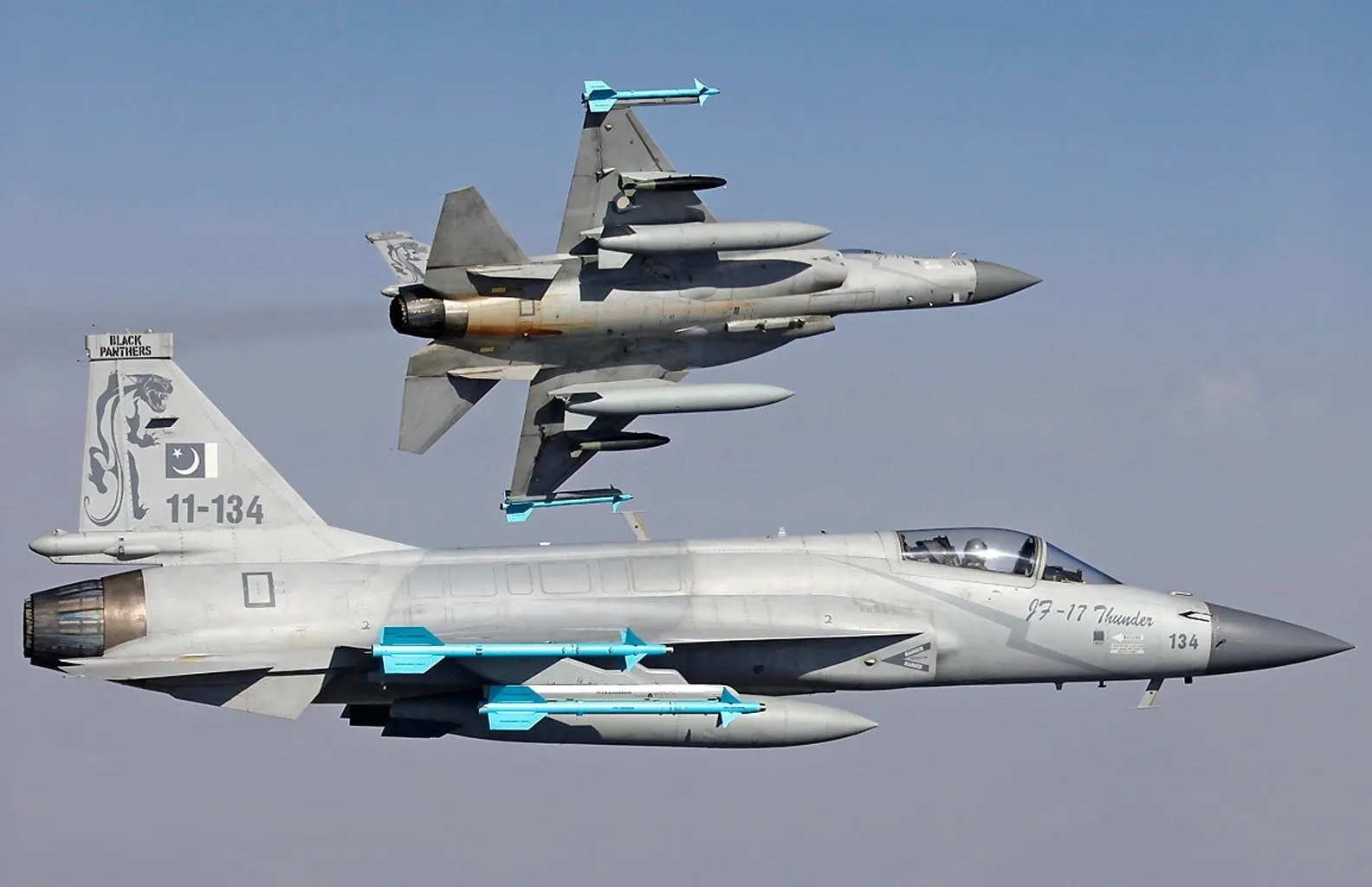 Pakistan Air Force JF-17 Thunder fighter jets. (Image Credit: PAF)
Pakistan Air Force JF-17 Thunder fighter jets. (Image Credit: PAF)Missiles and Air Defense Systems:
• PL-15: Chinese-made long-range air-to-air missile, used on J-10C and JF-17 fighters. PAF recently published a video of JF-17 Block III fighter aircraft armed with the long-range PL-15 beyond-visual-range air-to-air missile (BVRAAM). PL-15E (export variant) has a range of 145 km.
• HQ-9B: The HQ-9BE is a Chinese-made long-range air defense system deployed by the Pakistan Air Force, capable of targeting aircraft, cruise missiles, and ballistic threats. Its enhanced variant offers a range of up to 260 km against aircraft and 25 km against tactical ballistic missiles.
• Fatah MLRS: The Fatah-series is a family of guided rocket systems, offering short to medium-range, surface-to-surface missiles for targeted operations.
ALSO READ:
Regions
Issues

















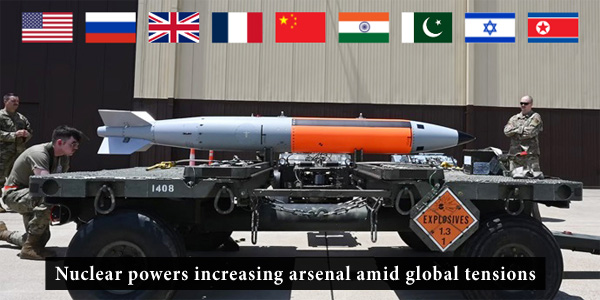 World Nuclear Powers Increasing Arsenal Amid Global Tensions
World Nuclear Powers Increasing Arsenal Amid Global Tensions
 Future Battlefield: Cybersecurity and AI in National Security Policy
Future Battlefield: Cybersecurity and AI in National Security Policy








